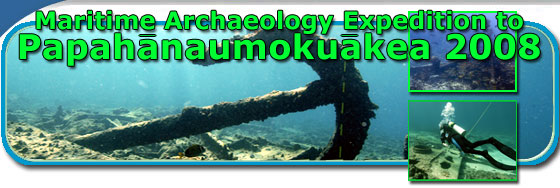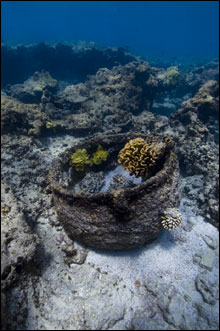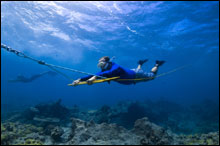 | ||||||||||||
|
|
|

On our way back down the archipelago, the schedule provided for another three-day stopover at French Frigate Shoals. Here, the apex predator team would resume tagging sharks, the coral team would continue to survey the habitat, the traditional ecological knowledge team would examine more habitat for comparison, and the maritime archaeology team would move beyond the Churchill site and on toward the northern parts of the atoll. With the Churchill site plan complete, our next task at French Frigate Shoals was to search for some of the other shipwreck that have been recorded lost here. Easier said than done--looking for a shipwreck site at this large atoll is a little bit like looking for a needle in a haystack. Nevertheless, this is where careful planning and historic research can pay off. For years, Hans has been studying historic maps and records noting the areas of probable losses. We decided to begin our survey at the location of an historic along the north side of the atoll. This is a large area, and we started our search on towboards, which puts two divers in the water astern of the small boat. Towboarding is generally an enjoyable task, and most people are eager to take their turn. This being Jason’s birthday, he got to go first, naturally wishing for a new shipwreck discovery.
Nevertheless, the identity of this unexpected find remains a mystery. What ship could this be trapped on the sea floor beneath the waves at French Frigate Shoals for so long? Only three whaling ships, all American vessels, have been reported lost at French Frigate Shoals: the South Seaman, a wrecked in 1859; the Daniel Wood, wrecked in 1867; and the Two Brothers, a Nantucket whaler wrecked in 1823 (the Two Brothers was well-known in her time for her ties to the story of the whaler Essex, made famous in recent years by author Nathaniel Philbrick in his bestselling book, In the Heart of the Sea). The maritime archaeology team collected a considerable amount of information at the site: measurements, distribution, and location of artifacts are all clues that will help us to figure out what the identity of this ship may be and how it likely came to its end. The team will take this data, the still and video images, measurements, and field notes back to shore. From there, we will search through archives, consult our peers and experts in the field, and begin to put the pieces of this shipwreck site together. Just as developing a research design to determine the areas of probable loss for shipwreck sites took years of historic research, determining the identity of this shipwreck site may take months, maybe years. We will be patient and appreciate the journey as we discover the true story behind this unidentified whaling shipwreck site for the time being named the “Shark Island Whaler” after the nearby sandy island. For now, we are excited to have another piece of the Monument’s maritime heritage story uncovered. This whaling shipwreck site and the others we’ve examined this month once again reminds us of how much history lies within these remote atolls. And for Jason, it was probably the most exciting birthday present the Monument could have given him.
|
||||||||||
|
||||||||||||





